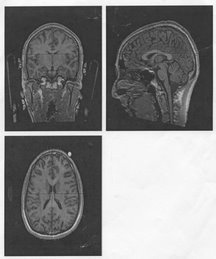Video from You Tube.
Everyone has their moments where you do something stupid in a spontaneous instant of thoughtlessness and realize immediately afterwards that it was a mistake. Ideally these events are swept under the rug, never to be thought of again; however in reality embarrassing moments tend to be resurrected when you least expect it. Take a lecture of the neuroanatomy of the midbrain for instance. Our brains are amazingly adapted to process the information from our environment and focusing on that which is important. Undoubtedly, circumstances in our environment change and what was once environmental noise becomes acutely salient. Imagine walking down a sidewalk chatting on a cell phone. You don't consciously think about moving one foot in front of the other, nor do you have to visually focus on the stop signs, mailboxes, trees, fire hydrants, and other features you pass. You're aware of them but they don't command attention. In this mental zone, you cross an intersection and suddenly your brain surges and you notice the semi truck charging towards you-immediately stealing your attention and causing you to speed out of harms way. The superior colliculi in the midbrain tectum is responsible for directing this visual attention (FYI the inferior colliculi are involved in auditory processes). To beat a dead horse, this is also the area often involved in the startle response in horror movies ---the dark, eerie mood music before something or someone jumps from off screen and says boo (or worse)!
I first learned about the colliculi six years ago when I was enrolled in Introduction to Cognitive Neuroscience course as a freshman at DU. During midterms, I was having a study group in my room in J-Mac with a neighbor also enrolled in the course while my roommate was on his bed, studying for a computer science test. In a moment of inspiration when we made it to the superior colliculi on the review guide, I picked up my stuffed elephant and chucked it unannounced at my roommate, intentionally aiming to miss his body and enter his peripheral vision to "demonstrate" the function of the superior colliculus. Unfortunately I miss judged my own strength and aim indeed missing Kevin's body instead making contact on his laptop sitting on the desk which proceeded to slide off the edge onto the floor with a loud crash. The unintended consequence of knocking off his laptop with my stuffed elephant did indeed direct the attention of everyone in the room in disbelief both at me and at the humpty dumpty laptop now on the floor. Flushed red I offered my sincerest apology stuttering something like, "i'm so sorry, I was just trying to test your superior colliculi response, I didn't mean to hit your computer, I was just aiming at you..."
Fortunately, my computer science roommate was able to repair his computer without lasting deficits and he even accepted my explanation for the vicious elephant-computer assault. Furthermore I passed my cognitive neuroscience midterm blocking out most recollection of the study session completely. That was of course until last week when I was in a group study session cramming for the Neuroscience Systems exam tracing tracts from the spinal cord through the hind and midbrain sections. Although we were focusing on the anatomical/histological regions of the sections, rather than the functional, I turned to my study partner and said, "you know, the superior colliculi is involved in the startle response...we should test it out!" A little voice in my mind started screaming-NO DON'T DO THAT!!! Do you remember the last time you tired that???

Image from Dr. Bales- G. Bales / Medical Neuroanatomy / Brainstem Topography 3/10/08

